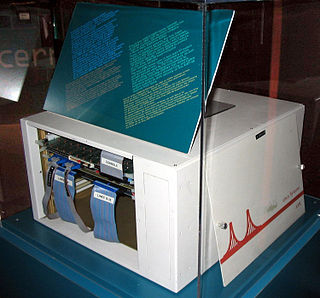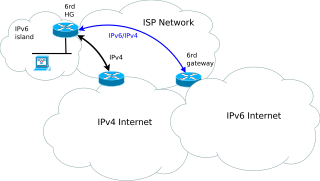An Internet Protocol address is a numerical label assigned to each device connected to a computer network that uses the Internet Protocol for communication. An IP address serves two principal functions: host or network interface identification and location addressing.
Internet Protocol version 6 (IPv6) is the most recent version of the Internet Protocol (IP), the communications protocol that provides an identification and location system for computers on networks and routes traffic across the Internet. IPv6 was developed by the Internet Engineering Task Force (IETF) to deal with the long-anticipated problem of IPv4 address exhaustion. IPv6 is intended to replace IPv4. In December 1998, IPv6 became a Draft Standard for the IETF, who subsequently ratified it as an Internet Standard on 14 July 2017.

A router is a networking device that forwards data packets between computer networks. Routers perform the traffic directing functions on the Internet. Data sent through the internet, such as a web page or email, is in the form of data packets. A packet is typically forwarded from one router to another router through the networks that constitute an internetwork until it reaches its destination node.
Classless Inter-Domain Routing is a method for allocating IP addresses and IP routing. The Internet Engineering Task Force introduced CIDR in 1993 to replace the previous addressing architecture of classful network design in the Internet. Its goal was to slow the growth of routing tables on routers across the Internet, and to help slow the rapid exhaustion of IPv4 addresses.
Multihoming is the practice of connecting a host or a computer network to more than one network. This can be done in order to increase reliability or performance.
In the Internet addressing architecture, a private network is a network that uses private IP address space. Both, the IPv4 and the IPv6 specifications define private addressing ranges. These addresses are commonly used for local area networks (LANs) in residential, office, and enterprise environments. Private IP address spaces were originally defined in an effort to delay IPv4 address exhaustion.
6to4 is an Internet transition mechanism for migrating from Internet Protocol version 4 (IPv4) to version 6 (IPv6), a system that allows IPv6 packets to be transmitted over an IPv4 network without the need to configure explicit tunnels. Special relay servers are also in place that allow 6to4 networks to communicate with native IPv6 networks.
A route distinguisher is an address qualifier used only within a single internet service provider's Multiprotocol Label Switching (MPLS) network. It is used to distinguish the distinct virtual private network (VPN) routes of separate customers who connect to the provider.
BGP hijacking is the illegitimate takeover of groups of IP addresses by corrupting Internet routing tables maintained using the Border Gateway Protocol (BGP).

The Réseaux IP Européens Network Coordination Centre is the Regional Internet Registry (RIR) for Europe, West Asia, and the former USSR. It is headquartered in Amsterdam, with a branch office in Dubai.
A provider-independent address space (PI) is a block of IP addresses assigned by a regional Internet registry (RIR) directly to an end-user organization. The user must contract with an Internet service provider to obtain routing of the address block within the Internet.
IPv4 address exhaustion is the depletion of the pool of unallocated IPv4 addresses. Because there are fewer than 4.3 billion addresses available, depletion has been anticipated since the late 1980s, when the Internet started to experience dramatic growth. This depletion is one of the reasons for the development and deployment of its successor protocol, IPv6. Currently IPv4 and IPv6 coexist in the Internet.
A forwarding information base (FIB), also known as a forwarding table or MAC table, is most commonly used in network bridging, routing, and similar functions to find the proper output network interface to which the input interface should forward a packet. It is a dynamic table that maps MAC addresses to ports. It is the essential mechanism that separates network switches from Ethernet hubs. Content-addressable memory (CAM) is typically used to efficiently implement the FIB, thus it is sometimes called a CAM table.
Deployment of Internet Protocol Version 6 (IPv6), the next generation of the Internet Protocol, has been in progress since the mid-2000s.

An Internet Protocol Version 6 address is a numerical label that is used to identify a network interface of a computer or a network node participating in an IPv6 computer network.

6rd is a mechanism to facilitate IPv6 rapid deployment across IPv4 infrastructures of Internet service providers (ISPs).

Carrier-grade NAT (CGN), also known as large-scale NAT (LSN), is an approach to IPv4 network design in which end sites, in particular residential networks, are configured with private network addresses that are translated to public IPv4 addresses by middlebox network address translator devices embedded in the network operator's network, permitting the sharing of small pools of public addresses among many end sites. This shifts the NAT function and configuration thereof from the customer premises to the Internet service provider network.
In order to ensure proper working of carrier-grade NAT (CGN), and, by doing so, alleviating the demand for the last remaining IPv4 addresses, a /10 size IPv4 address block was assigned by Internet Assigned Numbers Authority (IANA) to be used as shared address space.





